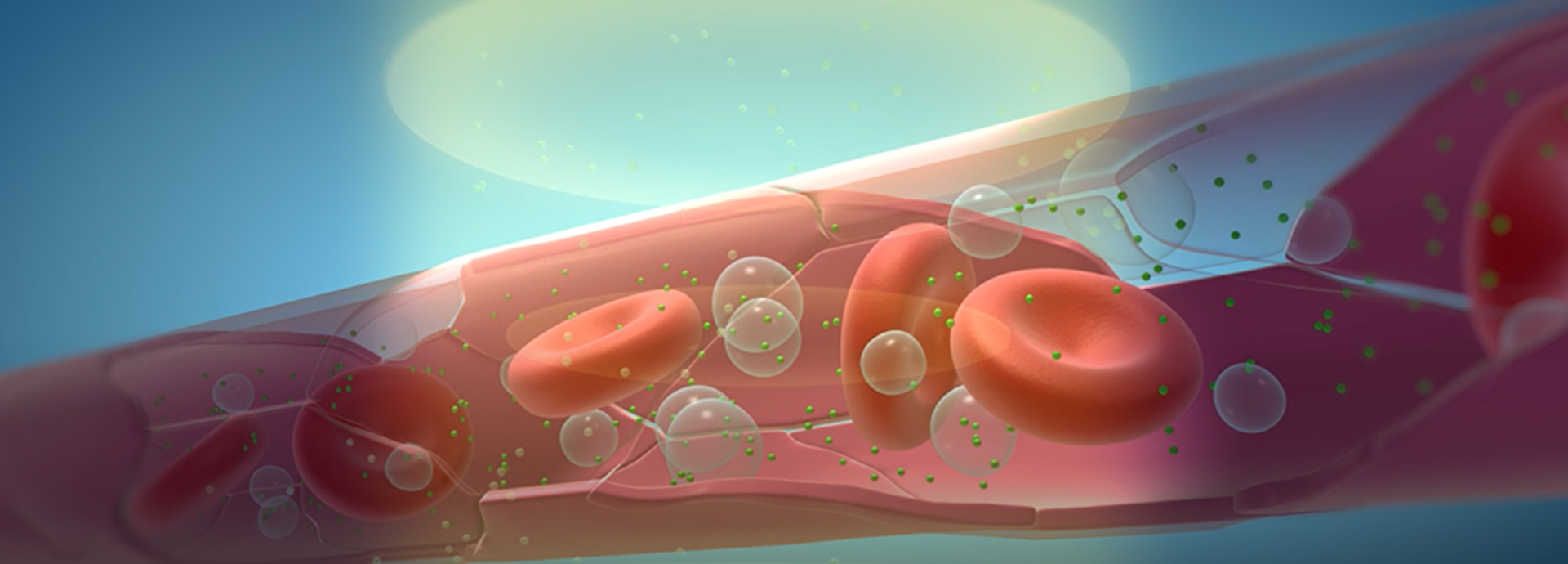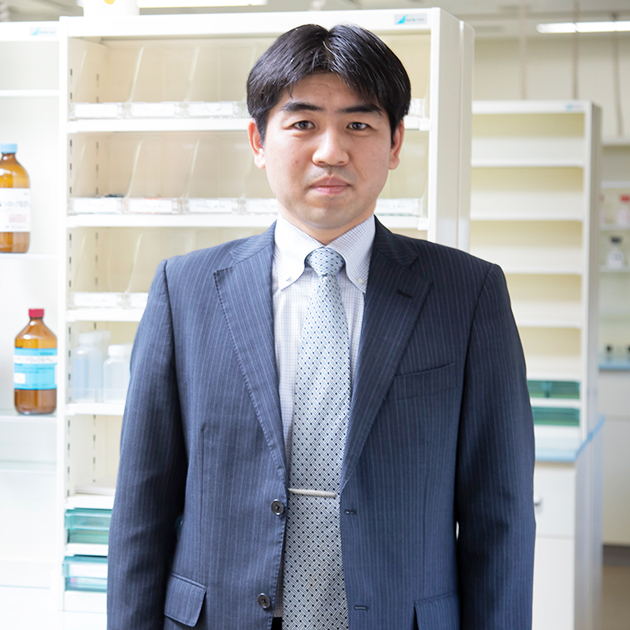By applying ultrasonic waves to bubbles (microbubbles) that are smaller than red blood cells,
DDS (Drug Delivery System) that concentrates and delivers drugs to targeted cells and tissues.
It is expected that the results of this research will be useful in the treatment of cancer and diseases of the brain and central nervous system.
Professor Ryo Suzuki, who works on research on microbubbles,
We are trying to open up new possibilities by adding various functions to these small bubbles.
With microbubbles and ultrasound
Deliver the drug to the target

Medicines are indispensable for treating and preventing illnesses and maintaining good health, but they can also be poisonous depending on how they are used. For example, anticancer drugs are known to have various side effects because they damage not only cancer cells but also normal cells. To minimize such side effects and maximize the effectiveness of the drug, it is necessary to deliver the required amount of drug only to the cancer cells.
Professor Ryo Suzuki of the Teikyo University School of Faculty of Pharmaceutical Sciences Drug Delivery Laboratory is researching a drug delivery system (DDS) that uses tiny air bubbles called microbubbles to deliver drugs to a targeted location. The microbubbles he is researching have diameters of 1μm (0.001mm) to 3μm, smaller than red blood cells in the blood. When ultrasound is applied to these microbubbles as they flow through the blood, the microbubbles in the blood vibrate, making it possible to visualize the blood flow inside the blood vessels where the microbubbles are located.
"Because the vibration of the microbubbles makes it possible to see blood flow that was previously invisible, it is possible to detect and diagnose abnormal blood flow in the heart and minute blood flow (angiogenesis) created by cancer cells. We are using that technology to develop a DDS that allows the required amount of drug to act when and where it is needed. "(Professor Suzuki)
Blood-brain barrier opening technology
When ultrasonic waves are applied to the microbubbles in the blood, the microbubbles contract and expand (vibration). In addition, the microbubbles collapse as the ultrasonic energy is gradually increased. When the mechanical action due to the vibration or crushing of such microbubbles is induced in the blood vessel, the blood vessel wall in the area irradiated with ultrasonic waves is expanded, and a small gap is opened in the blood vessel. As a result, the drug flowing in the blood vessel leaks to cells and tissues outside the blood vessel. This mechanism is the DDS that delivers medicines to the necessary cells and tissues in a pinpoint manner.
Not only delivering medicines to cancer cells
Also has the effect of activating immune cells
Microbubbles developed for medical use have hydrophobic gas covered with an outer shell such as lipid. If it is used as a contrast medium for blood flow, there is no problem in this state, but it has the disadvantage that it is not stable in blood and disappears in a few minutes when used with DDS. Professor Suzuki and his colleagues, who have been thinking about using it in DDS, which requires higher functionality, focused on the outer shell component of microbubbles. We have succeeded in providing functions according to the purpose, such as modifying the surface of the bubble with a target molecule that makes it easier to gather in a specific place.

One of the targets is cancer tissue. Cancer tissue is characterized by having more new blood vessels than normal tissue, but even among normal tissues, it is rich in blood vessels and easily affects hair roots, intestinal tract, bone marrow, etc., which are prone to growth, such as hair loss, vomiting / diarrhea, and cytopenia. It will cause side effects. In addition, for pancreatic cancer, which has a small blood vessel volume and is difficult to deliver drugs, and breast cancer, which has a large blood vessel volume but easily metastasizes to the brain and lungs, a large number of anticancer drugs can be pinpointed to the tumor. Must be delivered.
Therefore, Professor Suzuki administers an anticancer drug and microbubbles at the same time, and irradiates the target cancer tissue with ultrasonic waves from outside the body. The microbubbles were vibrated and crushed, causing the anticancer drug to leak into cells outside the blood vessels. Experiments with mice have shown that the same effect can be achieved with 1/5 of the usual dose of the drug.
"Currently, we are administering microbubbles and anticancer drugs at the same time. Eventually, we will load the anticancer drugs on the microbubbles and modify the molecules that actively gather on the surface of the microbubbles. I would like to realize that as well. "(Professor Suzuki)
Dynamics control using ultrasonic waves of anticancer drugs
Regarding cancer treatment, it has been found that there are effects other than drugs. When ultrasonic waves are applied by flowing only microbubbles without using drugs, cells involved in antitumor immunity called cytotoxic T cells against cancer cells are activated and attack the cancer cells.
"If the immune system against cancer cells can be activated, the range of treatment will expand, such as the immune system attacking metastatic cancer that is difficult to treat with drugs" (Professor Suzuki).
If it can penetrate the blood-brain barrier
Expanding the possibilities of dementia treatment
Increased vascular permeability with microbubbles and ultrasound may lead to the treatment of "brain disorders" that modern medicine cannot overcome. The number of people who develop various brain diseases with aging, such as dementia such as Alzheimer's disease and Parkinson's disease, brain tumors, and nerve cell damage due to cerebral infarction, has become a major social issue. To that end, the world has been working on the development of therapeutic and preventive drugs, and despite many reports that they have achieved sufficient results at the laboratory level, all drugs are effective at the stage of clinical trials. Not done.
The cause is the problem of the blood-brain barrier (BBB). At the blood-brain barrier, vascular endothelial cells in the brain are strongly bound to each other by "tight junctions", and foreign substances cannot easily enter the brain. Thanks to this, the important brain is protected, but the medicine in the blood cannot penetrate into the brain, so the medicine does not work.
Examination of Blood-Brain Barrier (BBB) Opening
In an experiment in which Professor Suzuki et al. Injected microbubbles and a drug from the tail of a mouse and irradiated ultrasonic waves from above the skull, it was confirmed that the drug permeated through the capillaries of the brain and migrated into the brain.
"If we can overcome the big hurdle of the blood-brain barrier, we may be able to re-examine effective drugs from the dementia treatment drugs that were previously considered ineffective. A similar announcement was made by an overseas research team. Results such as stimulating nerve cells in the brain and treating intractable brain tumors have also been reported, and it is likely to greatly expand the therapeutic potential of brain and central nervous system diseases. "(Suzuki) Professor)
To realize theranostics
Established a university-launched venture
Professor Suzuki and his colleagues, who have been conducting research and development on microbubbles, established WellThera (representative is Professor Emeritus Kazuo Maruyama), a university-launched venture, with the aim of developing more effective functional microbubble formulations and manufacturing investigational drugs. did. Microbubbles can be used as an ultrasound contrast agent and as a therapeutic tool for DDS. In recent years, the term Theranostics has been coined for a system that can perform both diagnosis and treatment with a single tool. This word is a coined word that combines Therapeutics (treatment) and Diagnostics (diagnosis), and is the medical technology that Professor Suzuki and others are aiming for with microbubble DDS.
"In conventional cancer treatment, the treatment policy is decided based on the test results, and the treatment is performed several days later. On the other hand, if the test drug has a therapeutic effect such as a microbubble preparation, the test and treatment are performed at the same time. There is a merit that it can be treated reliably while minimizing the burden on the patient. For the future progress of medical treatment, we must realize seranostics. "(Professor Suzuki)
In order to realize theranostics, it is indispensable to collaborate with a wide range of research areas such as ultrasonic technology in both hardware and software, medical knowledge by disease, in addition to microbubble technology. "I also feel the real thrill of teaming up with experts from various fields inside and outside the university to attack niche boundaries," says Professor Suzuki.
In the treatment of cancer and brain / central nervous system diseases, DDS using microbubbles is producing results, and it has the potential to establish further treatment methods depending on the functions to be added in the future. Professor Suzuki will challenge all possibilities with the desire to "eliminate the pain of many patients with DDS and contribute to the improvement of quality of life (QOL)".





